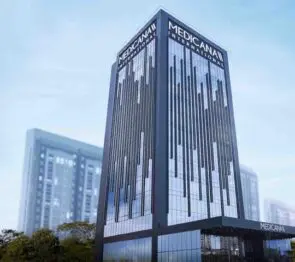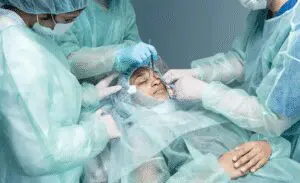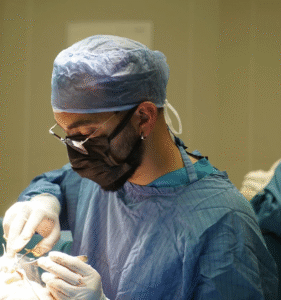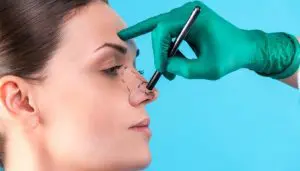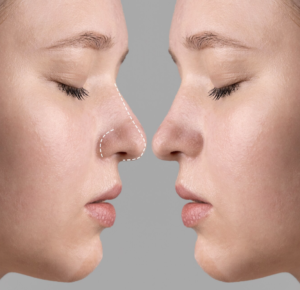Features of Recovery after Rhinoplasty
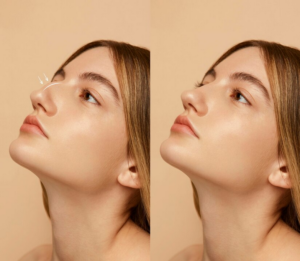
Rhinoplasty remains one of the most popular plastic surgeries. But many patients are concerned about the long recovery period after it. Let’s take a detailed look at how rehabilitation after rhinoplasty occurs and what you need to know for the most comfortable recovery.
Stages of the operation
Before discussing rhinoplasty recovery, it is important to briefly describe the procedure itself. The surgery typically takes 1 to 3 hours under general anesthesia. The surgeon makes incisions inside the nose or at the base of the septum, then reshapes the cartilage and bone, removes excess tissue, or adds implants. Stitches and a bandage are then applied.
Dr. William J. Casey, a plastic surgeon at the Mayo Clinic, notes, “Rhinoplasty is a complex procedure because the nose is a complex three-dimensional structure. Modern rhinoplasty techniques allow for very small changes that can still have a significant impact on the appearance and function of the nose. These techniques minimize trauma, which allows for better recovery.”
Although the procedure sounds complex, most patients report that the hardest part is deciding to have rhinoplasty. The success of the procedure depends on following your doctor’s instructions and being patient during the recovery period.
If you are considering rhinoplasty, you can get a free consultation by simply filling out the form below. Our medical specialists will contact you as soon as possible to answer all your questions and help you make an informed decision.
Caring for the nasal cavity after surgery
Immediately after rhinoplasty, tampons and silicone splints are installed in the nose. This stage may cause discomfort, but it is short-lived – usually a few days. After removing the tampons, home nasal care begins.
The key rule of postoperative care is strict adherence to the doctor’s instructions. As a rule, rinsing the nose with saline solution and using special sprays to cleanse crusts and mucus, as well as moisturize the mucous membrane, are prescribed.
Many patients are afraid of pain, but modern rhinoplasty techniques minimize pain. The main discomfort is associated with nasal congestion and swelling, which gradually disappear.
How to Clean Your Nose After Rhinoplasty
Proper nasal hygiene is the most important aspect of rehabilitation after rhinoplasty. At first, you cannot blow your nose in the usual way. Instead, use special solutions for rinsing, such as sea water. Rinsing should be done carefully, allowing the liquid to flow out on its own, without using force.
If necessary, clean the nose with cotton swabs soaked in hydrogen peroxide. Be extremely careful, without penetrating deep inside.
Marina S., a patient who underwent rhinoplasty 6 months ago, shares: “At first, the process of cleaning the nose seemed difficult, but after a week I got used to it and performed all the procedures automatically. The main thing is not to rush and be careful.”
How long does rehabilitation last: stages of the recovery period
Rehabilitation after rhinoplasty is a step-by-step process. Let’s consider each step in detail so that you can psychologically prepare and properly plan your recovery time.
Immediately after the operation
The first hours after rhinoplasty are under the supervision of medical staff. Mild nausea from anesthesia is possible, but it quickly passes. The nose is bandaged, tampons and silicone splints are in the nostrils. Breathing is done through the mouth, which is unusual at first.
First early stage: 0-7 days
This period is considered the most difficult in the rehabilitation of the nose after rhinoplasty. There is swelling of the face and bruises under the eyes. The nose is stuffy, breathing is difficult. However, this is a normal condition that gradually improves.
On the 2-3 day, the doctor removes the tampons from the nose, which immediately brings significant relief. About a week later, the plaster cast or other fixing bandage is removed, and the first results of the operation can already be seen.
During this period, it is especially important to strictly follow the recommendations for rehabilitation after rhinoplasty. The nose should not be touched, you should avoid tilting your head down and sleep exclusively on your back. It is also necessary to exclude hot, spicy and fried foods from the diet, as well as give up hot drinks and alcohol.
Second stage: 7 days-2 weeks
The swelling gradually goes away and breathing improves. You can start returning to your normal life, but it is better to refrain from work for now – the body needs time to recover after rhinoplasty.
Third stage: 1 month
By this time, most patients feel much better. The swelling has almost gone down, and the nose has acquired a more or less final shape. You can return to work and light physical activity.
Late recovery period: 6 months–1 year
Although it seems that the main stage of rehabilitation after rhinoplasty is behind us, full restoration of the tissues of the nose can take up to a year. During this time, the shape of the nose may still change slightly. Therefore, do not rush to final conclusions – give time to complete the recovery process.
Possible side effects
Rhinoplasty, like any surgical intervention, may be accompanied by side effects. However, most of them are temporary and go away on their own during the rehabilitation process.
The most common are:
- Swelling and dark circles under the eyes
- Nasal congestion
- Numbness at the tip of the nose
- Headaches
- Difficulty breathing
- Sore throat (from intubation during surgery)
- Lack of smell and taste for the first couple of weeks
- Slight increase in body temperature for the first 3 days
Less common:
- Bleeding
- Infection
- Nasal asymmetry
- Nasal septum perforation
It is important to remember that the risk of complications is significantly reduced by choosing an experienced surgeon and strictly following the recommendations for rehabilitation after rhinoplasty.
Diet during the recovery period
Proper nutrition plays a key role in the rehabilitation process after rhinoplasty. Many patients have a question about what the diet should be during this period.
In the first days after the operation, it is recommended to eat soft, low-fat food at room temperature. Avoid hot and cold dishes, as this can increase swelling. You should also avoid spicy, salty and smoked foods.
Particular attention should be paid to the drinking regime. It is recommended to drink at least 2 liters of water per day. This helps to remove residual anesthesia from the body and reduce swelling. Alcohol should be excluded for several weeks.
You can gradually return to your normal diet, but do not rush with solid food – active chewing movements can disturb the area of the operation.
Nutritionist Elena Sidorova recommends: “During the rehabilitation period after rhinoplasty, it is especially important to enrich the diet with foods rich in vitamin C and zinc, which promote rapid tissue healing. These can be citrus fruits, kiwi, bell peppers, pumpkin seeds.”
Tips to Speed Up Recovery After Rhinoplasty
To make the recovery process after rhinoplasty faster and more comfortable, use the following simple but effective recommendations:
- Sleep with your head elevated to reduce swelling and make breathing easier.
- In the first days after surgery, apply cold to the bridge of your nose.
- Do not wear glasses for at least 3 months after rhinoplasty.
- Avoid active physical activity and tilting your head.
- Protect your nose from the sun by wearing a wide-brimmed hat and sunscreen.
- Quit smoking – it slows down the tissue healing process.
- Rinse your nose daily with sea water or a special solution recommended by your doctor.
- Start taking light walks from the third day, but avoid excessive activity.
Remember that the results of rhinoplasty appear gradually, and the full picture will only be visible after a few months. Patience is the key to successful recovery after rhinoplasty.
What is strictly contraindicated during the recovery period?
During the entire recovery period after rhinoplasty, it is extremely important to adhere to the following restrictions in order to achieve the desired result:
- It is necessary to refrain from drinking alcohol for a month after the surgery.
- It is strictly forbidden to touch or massage the nose, even if such a desire arises.
- Contact sports should be avoided for at least two months.
- It is forbidden to visit a sauna, bathhouse or take hot baths for five to six months.
- It is forbidden to wear glasses for three months.
- It is also forbidden to sunbathe and visit a solarium for at least six months.
- You should not blow your nose with force for the first three months.
- Avoid having sex for the first three weeks after the surgery.
- It is strictly forbidden to remove crusts from the nose on your own.
These recommendations play an important role in successful recovery and achieving optimal results after rhinoplasty.
Recommendations of doctors in the postoperative period
Patients often ask about the time frame for returning to their normal activities. Here are the main recommendations for the recovery period after rhinoplasty:
- You can wash your face the day after surgery, but very carefully.
- You can take a shower after 2-3 days, protecting the bandage from getting wet.
- You can use cosmetics a week after removing the plaster cast, but avoiding the nasal area.
- Light physical exercise is allowed after 2-3 weeks.
- Swimming in the pool is possible no earlier than a month after surgery.
- Flights are allowed after 2 weeks, but it is better to consult a doctor.
- You can start sleeping on your side 1.5 months after surgery.
- Active sports are possible after 1.5 months.
It is important to remember that these time frames are individual and depend on the characteristics of the body and the type of rhinoplasty performed. Always consult with your surgeon for personalized recommendations for recovery.
Antibiotics after plastic surgery
Prescribing antibiotics after rhinoplasty is standard practice to prevent infections. The course usually lasts 5-7 days. It is important to take the entire course, even if you feel well, to prevent the development of resistant bacteria.
Antibiotics can cause side effects, such as an upset stomach. To minimize negative effects, strictly follow your doctor’s instructions and do not forget about probiotics.
Hygiene and care of the nasal cavity
Proper nasal care is a key aspect of successful recovery after rhinoplasty. Here are some important rules:
- Rinse your nose regularly with saline or sea water to cleanse the nasal passages and speed up healing.
- Use special moisturizing nasal sprays to prevent crusting.
- Do not try to remove crusts or mucus from your nose yourself. Use cotton swabs soaked in hydrogen peroxide, being extremely careful.
- Avoid sudden head movements and sneezing with your mouth closed.
- Do not use cosmetics in the nasal area for at least two weeks after surgery.
- If you need to clean your nose, do it very carefully, allowing the fluid to flow out on its own, without effort.
Remember that each case of rhinoplasty is individual, and your surgeon may give additional recommendations for care, taking into account the specifics of your surgery.
Rehabilitation after rhinoplasty is a long process that requires patience and careful attention to your body. Follow your doctor’s recommendations strictly, and you will definitely be pleased with the result. Remember that rhinoplasty is not only a change in the shape of the nose, but also a step towards improving the quality of life and increasing self-esteem.
Psychological aspects of rehabilitation after rhinoplasty
Rhinoplasty recovery involves not only the physical, but also the psychological aspect. Many patients experience anxiety and impatience while waiting for the final result. It is important to understand that full recovery takes time, and the intermediate stages may not reflect the final result.
Some patients may experience a temporary decrease in mood or even mild depression in the first weeks after surgery. This is a normal reaction to the stress associated with surgery and changes in appearance. Support from loved ones and a positive attitude play an equally important role in rhinoplasty recovery.
When can the final result of rhinoplasty be assessed?

Many patients are looking forward to seeing the final result of the surgery. However, it is important to remember that rehabilitation after rhinoplasty is a long process.
After 2-3 weeks after the surgery, you can already get the first impressions of the new shape of the nose, when the main swelling subsides. However, this is not the final result. Clearer contours of the nose will appear in 3-4 months.
You can fully evaluate the result of rhinoplasty no earlier than 6-12 months after the surgery. This is how much time is required for complete tissue restoration and the formation of the final contours of the nose.
Possible corrections after rhinoplasty
Sometimes, after the rehabilitation period, minor correction of the rhinoplasty results may be required. This does not mean that the first operation was unsuccessful, but only indicates the need for minor adjustments to achieve the ideal final result.
The question of the need for additional correction is decided by the doctor no earlier than a year after the primary rhinoplasty, when the rehabilitation process is completely completed. Such correction is usually less traumatic and requires less time for recovery.
Maintaining the results of rhinoplasty
After successful completion of rehabilitation, it is important to maintain the achieved result. Here are some recommendations for this:
-
- Continue to be careful when playing sports, especially contact sports.
- Use sunscreen on the nose area when exposed to the sun.
- Maintain a healthy lifestyle – proper nutrition and quitting smoking will help keep the skin of the nose in good condition.
- Visit your surgeon regularly for check-ups.
Conclusion
Rehabilitation after rhinoplasty is a complex process that requires patience, attention to your body and strict adherence to the doctor’s recommendations. Although the recovery period may seem long, remember that every day brings you closer to the desired result.
Proper care, adherence to diet and regimen, as well as a positive attitude are key factors for successful rehabilitation after rhinoplasty. Do not hesitate to contact your surgeon with any questions and doubts – his support and professional advice will help you go through this path with maximum comfort.
Remember that rhinoplasty is not only an aesthetic procedure, but also an opportunity to improve the quality of life by getting rid of breathing problems or complexes associated with the shape of the nose. Patience and the right approach to rehabilitation will definitely lead you to the desired result, and the new image will give you self-confidence and positive emotions.



